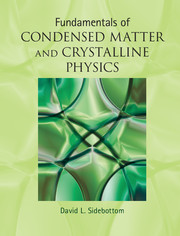 Fundamentals of Condensed Matter and Crystalline Physics
Fundamentals of Condensed Matter and Crystalline Physics Book contents
17 - Mean field theory and renormalization
from Part IV - Transitions
Published online by Cambridge University Press: 05 August 2012
Summary
Introduction
Our discussion of critical phenomena surrounding a second-order phase transition has thus far focused only on qualitative features. We have now examined three systems, fluids, magnets and random percolation, each of which displays an abruptly sharp transition from a less ordered to a more ordered phase as the respective transition point is encountered. Each shows a similar pattern of developing structure just in advance of the critical point. Fluctuations in the respective order parameter display a self-similar structure that is limited only by a single relevant length scale, the correlation length ξ, which diverges on approach to the transition point. For fluids and magnets, this structure arises from inherent fluctuations that are amplified by either a diverging compressibility or susceptibility, respectively.
In this chapter, we explore more quantitative, theoretical approaches taken to understand the features of second-order phase transitions. The simplest of these are the mean field theories, in which the pairwise interaction (needed to produce a phase transition) is introduced in the form of an average field. In this approach, the effects of the growing fluctuations of the order parameter near the critical point are ignored. Although the mean field approach does meet many of the requirements and does predict divergences of certain quantities near the transition, the critical exponents predicted by the theory do not match those seen experimentally. Obtaining correct exponents requires a more advanced approach involving renormalization techniques that exploit the self-similar structure of the fluctuations near the critical point and allow all of the various critical exponents to be inter-related, such that knowledge of any two yields all the others.
- Type
- Chapter
- Information
- Fundamentals of Condensed Matter and Crystalline PhysicsAn Introduction for Students of Physics and Materials Science, pp. 313 - 333Publisher: Cambridge University PressPrint publication year: 2012


